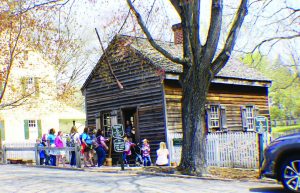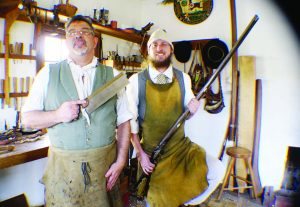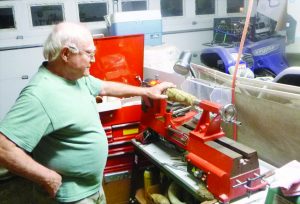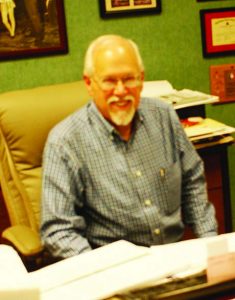By James C. Fulmer | Past President, NMLRA
“Ageing seems to be the only available way to live a long life.”
Daniel-Francois-Espirit Auber (1782-1871)
July 27th, 28th, & 29th, 2018 will be the 36th annual Gunmakers Fair at Dixon Muzzleloading Shop near Kempton, PA. I have attended the event since it has started. The show continues to be the premier event were muzzle loading gun builders bring their firearms and accoutrements from that time period to be judged. Items must be placed in the show starting at 2:00 PM by July 27th and the deadline for entries is 2:00PM on July 28th. The awards are given out after 2:00 PM on July 29th. The items must remain at the show until they receive any awards.

The Timothy Vogler Gunsmith Shop in Old Salem, NC, is a great place to visit.
It is truly three days of fun. There are seminars on gun building and other related accouterments given daily. The complete seminar listings are on the website: dixonmuzzleloading.com. The admission to the Fair is free, but there is a $5 parking fee. This event is where many long-term friendships have gotten started. A common bond of muzzle loading brings people from across the country and the world. Here is where you will have the opportunity to meet many gun builders you have only read about. Barrel makers, lock makers, powder horn makers, bag makers, knife makers, and many are ranked as “Masters” in their field.
During these 36 years, I have made many friends at Dixon’s Show. There are always the invites to “come visit me when you get the chance.” Since my retirement, I am taking many people up on their offers. This spring was a start of what I hope will be many great adventures with many great friends.

Master Gun Builder Blake Stevenson (left) is with Apprentice Bruce Stroud, who is holding a T. Vogler rifle.
One of the first people I visited was Jason Schneider of Rice Barrel Company, from Mocksville, NC. I had a great visit at his muzzle loading barrel shop, but as I was leaving he said, “You are going to Old Salem while you are here.” I replied with “what is “Old Salem.” He looked at me in astonishment and said, “If nothing else, you must visit Timothy Vogler’s original 1831 Gunsmith Shop. Don’t you know that is the oldest gunsmith shop still operating in the United States?” Up until he asked if I was going to “Old Salem,” I had never heard of it. Based on his recommendation, I went and I am glad I did.
It wasn’t hard to find, before it became “Old Salem” it was just Salem. Once I started looking into the history of Salem, NC, I quickly discovered Salem was founded by the Moravians. The Moravians were persecuted for their religious beliefs in Europe and would eventually come to America for freedom. They first tried to establish a community in Savannah, GA, in 1735, but it failed. They would establish themselves in Pennsylvania by first buying 500 acres of ground and establishing Bethlehem in 1741. Soon they bought another 5,000 acres and started the town of Nazareth in Pennsylvania, just north of Bethlehem. Another Moravian town was established at Lititz, PA.
From their base in Pennsylvania in 1753 the Moravians would settle a 100,000 acre tract of ground in what is now North Carolina. It would be called Wachau and eventually the name would be anglicized to Wachovia. The town of Salem was founded in 1766 and would become the heart and center of the Moravian settlement. From the beginning, Salem was known as a “trades town.” Craftsmen produced guns and ironware, ceramics, furniture, tin smithing, silver smithing, shoes, bakery products, and of course the libations for 1784 Salem Tavern.
Many of the original buildings in the town of Salem survived two centuries of changes in the town. There was the first Krispy Kreme Doughnut Shop founded in what is “Old Salem” in 1937. But it wasn’t until 1947 that a proposed supermarket in the center of the old town motivated a group too quickly save the historic area. In 1950 a non-profit corporation, Old Salem Inc., was formed to save the old town. Today, Old Salem Historic District includes 87 acres of historic sites. Many are original buildings which offer a historically accurate recreation of 1766 to 1840 Salem. There are about 20 buildings open to visitors with paid admission. Many of the buildings have people in period-correct clothing demonstrating their trades. There are several shops open to the public without tickets and one of my favorite is Winkler Bakery. Here you can purchase right out of a 200-year-old wood-fired bake oven, bread and sugar cake. Both the bread and the sugar cake where great. For more information about Old Salem and their hours, go to the website: oldsalem.org.
But the reason I had gone to Old Salem was to see the Timothy Vogler Gunsmith Shop. Back on May 30, 1831 Timothy Vogler received permission from the Moravian Church to build a gun shop. The shop was finished that year and would become known for its finely-crafted North Carolina long rifles. The shop was used by Vogler as a gunsmith shop until the 1890s while he was living in an adjacent home.

Master Horner Walter Mabry is standing in his Mississippi shop where he makes powder horns.
Blake Stevenson, the assistant director of Historic Trades Manager of the T. Vogler Gunsmith Shop, along with his apprentice Bruce Stroud, recreate these North Carolina long rifles. All parts they use for these muzzle loading rifles come from their home state of North Carolina “lock, stock, and barrel.” If you get a chance stop by and visit “Old Salem,” the living history people at the museums are all very knowledgeable about what they do in recreating 18th-19th century trades and life styles.
I would leave North Carolina and travel onto two more of my friends who I would see at the Dixons Gunmakers Fair. I stopped in to visit my friend who lives in Mississippi, Walter Mabry, on my way to Texas. I first met Walter at the Gunmakers Fair. I also camped across from him for a lot of years at the National Muzzle Loading Rifle Association Championship shoots at Friendship, IN. On my visit to his house it was only then I realized he was a gun builder and had won many, many ribbons at Dixon’s over the years; 36 years does ad up quickly. I only knew Walter as a skilled powder horn maker who had just become a Master Horner in the Honourable Company of Horners this spring. Looking at all his life long work in his art work, from gun building, powder horn making and drawings, I was truly amazed. I am glad I took the time to stop.

Rex Reddick in his office at Crazy Crow Trading Company in Texas.
I would leave Mississippi and head to another friend’s house. Rex Reddick lives in Texas. Rex is a friend who I met many times at Dixon’s over the years. Rex and his wife Ginger own Crazy Crow Trade Company. Rex started the business in 1970 where Native American, Rendezvous, Reenactors and Crafts people can go to get supplies. I sent for his catalog back in the early 1970s, and I know as Chief Range Officer for Council Cup Muzzle Loaders, we were ordering prizes from him. I was surprised when I met him; I thought he would have been older. He started out with a hobby that got away from him and turned into a business. He started pretty young in this sport and it turned into a way of life.
When I stopped at his warehouse near Pottsboro, TX, I was impressed by how some items in the catalog are produced in house. I assumed, which is always dangerous, that items were mostly imported. I was wrong on that one. I am always surprised about how much I don’t know. If you never seen the supplies he has, go to www.crazycrow.com. He has a whole line of almost everything you need to get started in living history at a fair price.
I will be seeing Rex and Walter at Dixon’s this July with many others. I am looking forward to seeing my old friends and making new ones. For many, many people like Rex, Walter, and me, our hobby turned out to be a way of life. Pass it on.



